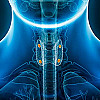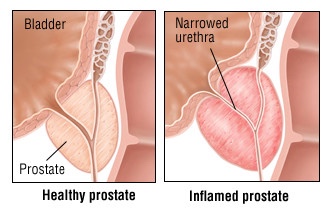Recent Blog Articles

How — and why — to fit more fiber and fermented food into your meals

Tick season is expanding: Protect yourself against Lyme disease

What? Another medical form to fill out?

How do trees and green spaces enhance our health?

A muscle-building obsession in boys: What to know and do

Harvard Health Ad Watch: New drug, old song, clever tagline

Concussion in children: What to know and do

What color is your tongue? What's healthy, what's not?

Your amazing parathyroid glands

When — and how — should you be screened for colon cancer?

On this page you'll discover
- Prostate function - What does my prostate do?
- What are common prostate problems?
- What causes prostate problems?
- Who develops prostate problems and how common are they?
- What are the symptoms of prostate problems?
- When to see a doctor if you have symptoms?
- How can I prevent a prostate problem?
- What is prostate cancer?
- What is the main cause of prostate cancer?
Prostate Health
The prostate gland isn't big—about the size of a walnut—but its location virtually guarantees problems if something goes awry. The prostate gland is located just below the bladder and in front of the rectum. It also wraps around the upper part of the urethra, the tube that carries urine from the bladder out of the body. That means prostate problems can affect urination and sexual function.
The prostate is prone to three main conditions: Prostatitis: infection or inflammation of the prostate; Benign prostatic hyperplasia (BPH): aging-related enlargement of the prostate gland; and Prostate cancer: the growth of cancerous cells inside the prostate, which may break out of the gland and affect other parts of the body.
Prostate function - What does my prostate do?
Your prostate plays a key role in reproduction. Although it’s the testicles that produce sperm, the prostate (along with tiny neighboring organs called seminal vesicles) helps produce semen—the viscous fluid in which sperm travel.
Here’s what happens when you ejaculate. Within the prostate, a series of ducts lined with fluid-producing cells pushes prostatic fluid out into the urethra (the tube that carries urine from the bladder) where it joins both the sperm produced by the testicles and the fluids generated by the seminal vesicles (narrow glands located on each side of the prostate).
The prostate consists of two lobes, right and left, and it’s wider at its base. The base of the prostate is higher up in your body, where the gland nestles against the bladder. The “apex” is the lower end, closer to the rectum. Between the apex and the base lies the mid-gland. These terms are important in discussions about prostate cancer, since the area of the prostate in which a cancer appears can affect symptoms, treatment options and outcomes.

What are common prostate problems?
Unfortunately, most men will experience some kind of prostate problem during their lifetime. Prostate problems are generally associated with three conditions: prostatitis, BPH, and cancer.
Prostatitis refers to an inflamed prostate. There are two main types: acute prostatitis and chronic prostatitis. Acute prostatitis is caused by an infection, usually by bacteria, and results in the sudden onset of painful urination, a small stream and often fever and chills, Chronic prostatitis, also known as chronic pelvic pain syndrome, is a less well defined condition. Its symptoms include persistent or recurrent pelvic discomfort, pain or burning with urination, an increased urge to urinate, difficulty emptying their bladders, and/or painful ejaculation. The underlying cause can be a chronic inflammation with or without an infection, and often the exact reason for symptoms can’t be found.
Benign Prostatic Hyperplasia (BPH), commonly called “enlarged prostate,” refers to the excessive growth of the gland that usually occurs after age 50; it can double or triple in mass during the latter decades of life. BPH is not caused by cancer (though it can occur alongside it).BPH can be considered an expected part of the aging process for most men. About half of cases are asymptomatic, but some men will experience problems. As the prostate expands in size, it effectively pinches off the urethra (the tube carrying urine from the bladder to the penis), making the muscular walls of the bladder have to work harder and causing problems with urination.
As with other cancers, prostate cancer is the abnormal growth of cells. Prostate cancer can be localized (limited to the prostate itself), regionally advanced (spread to surrounding tissue) or metastatic (spread to more distant sites). Recent years have seen great advancements in prostate-cancer screening, testing and treatment.
What causes prostate problems?
Acute prostatitis is usually caused by a bacterial infection. The exact cause of chronic prostatitis/chronic pelvic pain syndrome is often not discovered. One possibility is that the immune system mistakenly targets the prostate, blasting the gland with inflammatory compounds. Another possibility is bacterial or fungal infections that go undetected by standard testing methods. Certain foods may also trigger symptoms, as might stress and depression, chronic pain conditions, trauma to the genitourinary area, and repeated biopsies.
By far, the greatest risk factor for benign prostatic hyperplasia (BPH), or enlarged prostate, is age. However, prostatitis, a sedentary lifestyle, obesity, high blood pressure and diabetes have all been associated with the condition. And researchers have found correlations between BPH and a diet high in sugar, red meat and refined grains.
No exact cause of prostate cancer has been identified, although genetic defects (either inherited or uninherited) play a key role. Age is an important risk factor, as is family history: Men whose fathers or brothers had prostate cancer are two to three times likelier to get it themselves. Race appears to matter, as well—rates among African Americans are 60% higher than in white men. A diet high in red meat and saturated fats has been associated with increased risk, and obesity is a separate risk factor. Some studies suggest that men who ejaculate infrequently are at higher risk.
Who develops prostate problems and how common are they?
Most men who live into old age will develop some form of prostate problem, although symptoms can range from mild inconvenience, like having to get up during the night to urinate, to invasive cancers that can cause debilitating changes or even death.
Between 9% and 16% of men develop prostatitis (inflamed prostate) at some point during their lives. Unlike other prostate problems, prostatitis affects younger and older men equally. Each year, prostatitis leads to nearly 2 million doctor visits in the US. Men suffering from depression, anxiety and stress may struggle more with prostatitis symptoms, and men with other chronic pain conditions may be more susceptible. Prostatitis is not contagious.
Benign prostatic hyperplasia (BHP),or an overgrown prostate, is extremely common in older men. Although the majority of men with the condition (50-60%) never develop symptoms, the remainder seek treatment for a range of problems, such as a weak urine stream, a frequent urge to urinate, waking up at night to use the bathroom, leaking, and dribbling. A very large prostate may cause urinary obstruction, an inability to empty the bladder.
The American Cancer Society estimates that 268,490 men will be diagnosed with prostate cancer in 2022, with 34,500 dying from it, making it the second leading cause of cancer deaths among men in the US. Still, 98% of men survive for 10 years after diagnosis and 96% survive 15 years because most often prostate cancer is low-grade and stays localized within the prostate. Low grade cancers usually do not affect quality of life or lead to early death. The challenge is to identify the more aggressive cancers at an early stage. African Americans are at greater risk for prostate cancer, especially the more aggressive forms, than any other group in the US.

What are the symptoms of prostate problems?
Acute prostatitis caused by bacteria may only cause symptoms typical of infections, such as fever, chills, fatigue and muscle pain. There may also be pain or difficulty urinating.
Chronic prostatitis/chronic pelvic pain syndrome is characterized by a group of symptoms including frequent urge to urinate, burning and pain during urination, inability to empty the bladder, pain or difficulty ejaculating, and pain in the pelvis, lower back or perineum (the area between the scrotum and the rectum). Some men report a feeling of fullness in the rectum, and blood may appear in the semen. Some forms of prostatitis can cause spasming of the pelvic-floor muscles. Although not an observable symptom to the patient, prostatitis can increase blood levels of prostate-specific antigen (PSA).
The hallmark of BPH (benign prostatic hyperplasia, or enlarged prostate) is a cluster of symptoms known by the acronym LUTS (lower urinary tract symptoms). They include a weak, interrupted urine stream, more frequent urination (especially during the night), frequent urge to urinate, leaking or dribbling, and the feeling that you can’t quite empty the bladder. Over time, those symptoms may escalate to the point that the bladder can no longer push urine past the obstructing prostate, causing what’s known as acute urinary retention. An inability to urinate at all is not just painful but a true medical emergency because it can damage the kidneys. BPH also can raise PSA levels above the normal range.
Most prostate cancer diagnoses do not come from patients reporting symptoms but rather from blood tests that show high PSA levels, followed by biopsy. Patients with low-risk, non-aggressive cancers typically experience no symptoms at all. When men do notice signs of cancer, those symptoms tend to be difficulty urinating or bone or back pain because the cancer has spread.
When to see a doctor if you have symptoms?
Talk to your doctor if you experience any of the lower urinary tract symptoms (LUTS), which include a weak urine stream, increased urgency to urinate, inability to void the bladder completely, and more frequent urination. Other symptoms that should prompt a doctor’s visit are persistent or recurrent pain during or after ejaculation, blood in the semen, and pain around the base of the penis, the perineum, the lower back or the rectum.
If your symptoms are related to an enlarged prostate (BPH), you and your doctor will weigh the risks versus the benefits of treatment. A major consideration is the extent to which your symptoms are interfering with your lifestyle. For example, if you work in an office or need to travel frequently, then having to use the bathroom often is probably disruptive to your lifestyle in a way that it wouldn’t be if you were retired or worked from home. If your symptoms prevent you from engaging in enjoyable activities or if they’re noticeably worsening, discussing treatment options with your doctor is wise.
You can gauge the severity of your symptoms by completing a simple, seven-question, multiple-choice questionnaire to get what’s called an International Prostate Symptom Score (IPSS). You’ll be asked questions such as, “Over the past month, how often have you had to push or strain to begin urination?” and, “Over the past month, how often have you had a weak urinary stream?” Based on your responses, you’ll be able to tally up an overall score. If yours falls in the range of moderate to severe, you should talk to a doctor about treatment.
If you are unable to urinate, you’re experiencing a medical emergency and should seek prompt urgent care.
How can I prevent a prostate problem?
Since the causes of most prostate problems are unknown, you should think in terms of lowering risk rather than preventing problems. Certain lifestyle considerations have been associated with lower risk of enlarged prostate and prostate cancer. These include maintaining a healthy body mass, exercising, and eating a Mediterranean-style diet.
The most often used screening method to detect prostate cancer is the PSA (prostate-specific antigen) test. However, many conditions besides cancer might cause an elevated PSA score, so PSA tests often produce false-positive results. The current recommendation is to consider the pros and cons of screening and discuss it with your doctor if you still have questions. PSA screening can lead to excessive unnecessary biopsies and potential overtreatment.
What is prostate cancer?
All cancers begin when cells somewhere in the body start to grow out of control. Prostate cancers get their start in the prostate gland and may spread from there to other body parts. When the cancer remains limited to the prostate, it is known as localized prostate cancer. If it is found to be a low grad cancer on biopsy, often no immediate treatment is necessary. Periodic monitoring can determine if the cancer is still growing. Intermediate and high grade localized cancer can be treated with surgery or radiation therapy. Men who don’t have surgery might also be treated with a hormonal therapy called androgen deprivation therapy (ADT) to block production of testosterone, a key hormone for the promotion of cancer growth.
What is the main cause of prostate cancer?
No single cause of prostate cancer has been identified—nor can researchers conclusively state that any given factor causes the disease per se. Inherited genetic changes can sometimes be identified, and DNA-damaging chemicals in our environment may play a role.
Radiation, chemicals and inflammation can all cause mutations to cells’ DNA. When the cells divide, the mutations are repeated and can produce prostate cancer. These types of mutations occur within a man’s body after exposure to the stimulus and are not inherited.
Other genetic defects are indeed inherited from a man’s parents; these mutations are called germline defects. Two of the most common germline defects are found in the BRCA1 and BRCA2 genes, whose job is to repair damage to cells’ DNA. When the BRCA genes are defective, DNA damage inside cells can accumulate and form tumors. Some men with aggressive prostate cancers have defective BRCA genes (more commonly BRCA2). BRCA genes are not alone, though—recent research has found 16 DNA-repair genes that may be implicated in prostate cancer. Other cancer-related germline defects include mutations to the ATM gene, which regulates cell growth; the HOXB13 gene, which is involved in prostate development; and the CHEK2 gene, which blunts the effect of testosterone on the growth of cancer cells.
An inherited genetic mutation is more likely to be present in men with a strong family history of either prostate cancer or breast cancer in both females and males. A man with two or more first-degree male relatives (father and brothers) who have developed prostate cancer has five to 10 times greater risk than a man with no affected first-degree relatives.
While other factors (such as age, race, diet, obesity and exercise) no doubt contribute to a man’s overall risk profile, genetic defects are probably the strongest single predictor of who will and will not develop prostate cancer.
Recent Blog Articles

How — and why — to fit more fiber and fermented food into your meals

Tick season is expanding: Protect yourself against Lyme disease

What? Another medical form to fill out?

How do trees and green spaces enhance our health?

A muscle-building obsession in boys: What to know and do

Harvard Health Ad Watch: New drug, old song, clever tagline

Concussion in children: What to know and do

What color is your tongue? What's healthy, what's not?

Your amazing parathyroid glands

When — and how — should you be screened for colon cancer?
Free Healthbeat Signup
Get the latest in health news delivered to your inbox!
Sign Up

